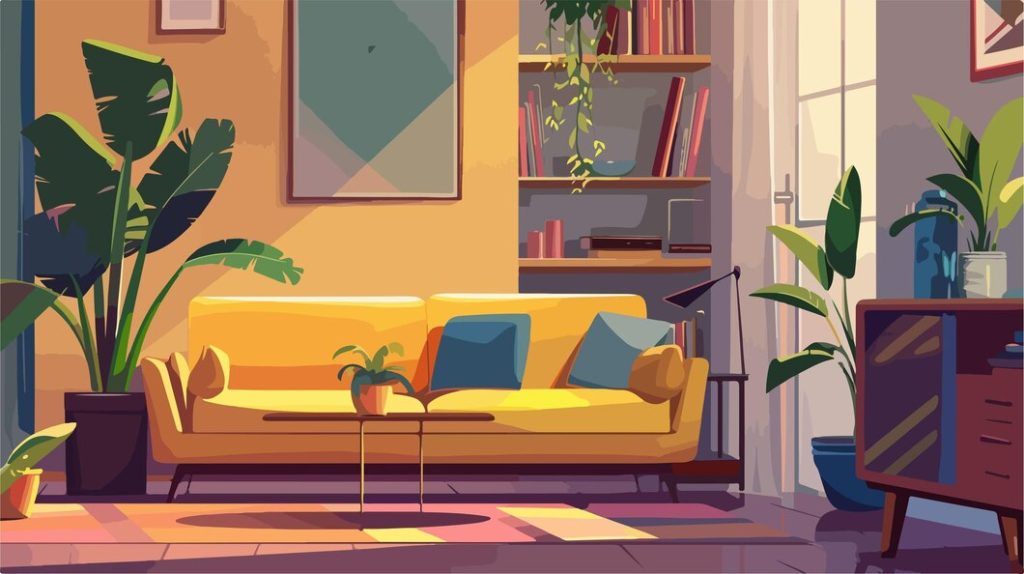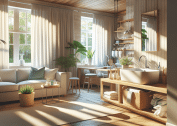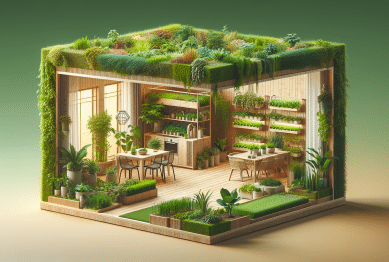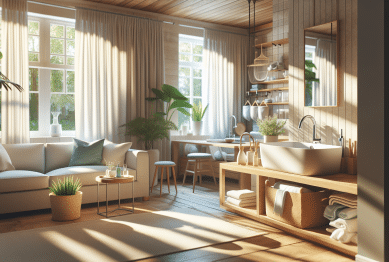In today’s fast-paced world, creating a home sanctuary has become more than just a trend—it’s a necessity. As people spend more time at home, there is a growing emphasis on designing spaces that promote relaxation, comfort, and overall well-being. A cozy living environment doesn’t just provide physical comfort; it also nurtures emotional and mental health. Whether you live in a small apartment or a spacious house, you can transform any space into a personal retreat with the right elements of cozy living. This guide will explore key aspects of designing a tranquil home sanctuary, covering everything from color schemes and furniture choices to lighting and decor that bring comfort and warmth into your living space.

1. Warm and Inviting Color Schemes
One of the simplest yet most effective ways to create a sense of coziness is through the use of warm and inviting color schemes. The colors you choose for your home play a significant role in setting the tone and atmosphere of your space.
Recommended Color Palettes for Cozy Living
- Earthy Tones: Shades of beige, taupe, and clay create a grounded and soothing environment.
- Warm Neutrals: Cream, caramel, and soft browns add warmth without overwhelming the senses.
- Muted Pastels: Light pinks, sage greens, and dusty blues bring a subtle hint of color while maintaining tranquility.
Why It Matters
Studies have shown that colors can influence mood and emotions. Warm tones evoke feelings of comfort and safety, making them ideal for spaces where you want to unwind and relax. Use these hues in living rooms, bedrooms, and reading nooks for maximum effect.
2. Layered Textures: The Key to Coziness
Texture is an often-overlooked aspect of creating a cozy home sanctuary. Adding layers of different materials and fabrics can make a space feel more inviting and comfortable.
How to Incorporate Textures
- Soft Throws and Blankets: Drape knitted or faux fur blankets over sofas and chairs.
- Plush Rugs: Choose high-pile or wool rugs for a soft and warm underfoot experience.
- Accent Pillows: Mix and match pillows with different fabrics, like velvet, linen, and cotton, to create a visually interesting and tactile space.
Why It Matters
Textural contrast adds depth and dimension to a room, making it feel more complete and inviting. Whether you’re using woven baskets, rustic wooden accents, or velvet cushions, textures can transform a flat space into a warm and cozy retreat.
3. Comfortable Seating: Invest in Quality
Your choice of seating is crucial when designing a home sanctuary. After all, creating a cozy living environment starts with having comfortable furniture that invites you to sit back and relax.
What to Look for in Cozy Seating
- Overstuffed Sofas: Look for deep sofas with plush cushions that support lounging.
- Reading Chairs: Add a comfortable armchair or wingback chair to create a reading nook.
- Ottomans and Poufs: These are great for extra seating or as a place to rest your feet.
Why It Matters
The more comfortable the seating, the more likely you are to use and enjoy the space. Invest in quality pieces that not only look good but also provide long-lasting comfort and support.
4. Ambient Lighting: Set the Mood
Lighting is another critical element in creating a cozy atmosphere. The right lighting can make a space feel warm and welcoming, while poor lighting can make even the most beautifully designed room feel cold and uninviting.
Tips for Cozy Lighting
- Use Warm Bulbs: Choose bulbs with a color temperature of 2,700K to 3,000K for a soft, warm glow.
- Layered Lighting: Combine overhead lights with floor lamps, table lamps, and candles to create a balanced and ambient lighting scheme.
- Dimmer Switches: Install dimmers to control the intensity of the light and adjust the mood of the room as needed.
Why It Matters
Lighting affects both mood and perception. A well-lit space feels inviting and comfortable, whereas harsh lighting can create a sterile and unwelcoming environment. Opt for soft, diffused lighting to enhance the cozy feel of your home.
5. Natural Elements: Bring the Outdoors In
Bringing natural elements into your home is a simple yet effective way to add warmth and tranquility to your living space. Houseplants, wooden accents, and natural fabrics can all contribute to a serene atmosphere.
Ways to Incorporate Natural Elements
- Houseplants: Use leafy greens and flowering plants to add life and color.
- Wooden Furniture: Opt for natural wood finishes on tables, shelves, and seating.
- Organic Fabrics: Choose cotton, wool, or linen for pillows, throws, and curtains.
Why It Matters
Research has shown that incorporating natural elements into interior design can reduce stress and promote well-being. Plants, in particular, have been linked to improved air quality and mental health.
6. Personal Touches: Make It Your Own
A home sanctuary should reflect your personal style and preferences. Adding personal touches like family photos, favorite books, or travel mementos makes the space uniquely yours.
Ideas for Personalization
- Gallery Walls: Create a gallery wall of your favorite artwork, photos, or quotes.
- Scented Candles: Use candles with your favorite scents to enhance the sensory experience.
- Sentimental Decor: Display items that have special meaning, such as heirlooms or souvenirs.
Why It Matters
Personal touches make a house feel like a home. They create a sense of belonging and comfort, which are essential elements of a cozy living space.
7. Decluttering: Less is More
Creating a sanctuary is not just about adding things to your space; it’s also about knowing what to remove. Clutter can make a space feel chaotic and overwhelming, so keeping your home organized and tidy is crucial.
Decluttering Tips
- Adopt a Minimalist Approach: Keep only items that serve a purpose or bring you joy.
- Use Storage Solutions: Invest in stylish storage baskets and shelves to keep clutter at bay.
- Regularly Reassess: Make it a habit to go through your belongings every few months and donate or discard items you no longer need.
Why It Matters
A clutter-free space promotes a sense of calm and order, making it easier to relax and enjoy your surroundings.
Final Thoughts: Creating Your Ideal Home Sanctuary
Designing a home sanctuary is about more than just aesthetics—it’s about creating a space that nurtures your mind, body, and soul. By focusing on comfort, personalization, and intentional design choices, you can transform any room into a peaceful retreat. Use these elements of cozy living to turn your home into a sanctuary where you can truly unwind, recharge, and find joy in the everyday moments.
References
- Better Homes & Gardens. (2024). Creating Cozy Spaces: Interior Design Tips. Available at: www.bhg.com.
- Houzz. (2023). Interior Design Trends to Follow in 2024. Available at: www.houzz.com.
- Psychology Today. (2024). The Impact of Color and Lighting on Mood. Available at: www.psychologytoday.com.









